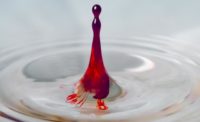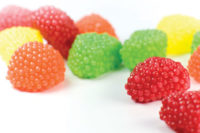Color has always been one of the confectionery industry’s strongest weapons in its attractability arsenal. Bright and bold. Inviting and awe-inspiring. Colors were not, however, always natural and organic, two movements that are changing the face of food processing, especially in candy.
In this Question & Answer session, participants Scott Ondracek (SO), DDW applications scientist; David Dukes (DD), president of IFC Solutions; Helle Rexen (HR), Interim Head of Media Relations – Chr. Hansen; and Michael Serrur (MS), director of communications at GNT USA Inc address some of the trends and issues facing confectionery manufacturers.
CI: Are companies still reformulating from artificial to natural colors? Is there still more work to be done regarding this shift for the confectionery industry?
SO: Yes, many companies are still looking to replace artificial with natural colors. A challenge remains that they want the natural colors to impart the same look, especially if it’s in a key brand. As we’ve seen with some conversions in the past, if the alternative is not the same as the original, customers may not be ready to accept the new formulation.
For the confectionery industry, this change is even more challenging as candy products often use bright and vibrant colors as part of their marketing. Matching these strong shades to the naturally derived options for yellows and oranges is fairly easy, but some blues and greens still remain an issue due to process temperatures used in traditional candy making processes and the somewhat limited selection of natural colors permitted in the U.S. market.
DD: By this point, many companies have found there is either genuine interest from their customers to “go natural,” or have found that reformulating is not worth the extra cost. While not a confectionery application, the situation with Trix Cereal last year was a real eye opener for many companies.
General Mills found more backlash from their customers once they went “all natural.” Our understanding was that the natural flavors played a role in the consumer rejection of the product. General Mills has since found that offering both options is a nice balance for them.
We always recommend to our clients looking to go “natural” that they consider adding a new natural line rather than completely eliminating their traditional product. We have seen some customers hit by heavy losses doing an entire shift. There seems to be some level of disconnect between what consumers say they want, and what they really want.
HR: The European confectionery market has overwhelmingly converted to natural colors or even to minimally processed colors (called Coloring Foods in Europe). In the United States, we see that smaller, more premium manufacturers have converted, or perhaps were launched with a “natural identity.” Confectionery is a highly consolidated market and most of the large companies are poised to convert to natural colors; the actual timing of conversion will depend on when they are confident they will be addressing consumer demand.
MS: Many companies have already incorporated natural colors into their food and beverage products. In Europe, the confectionery industry has largely adopted colors from fruits, vegetables and plants, and it looks like the U.S. market is ready to follow suit. Our global TNS study found that parents, a key consumer group for the confectionery industry, are especially sensitive to purchasing products containing artificial colors. We believe that this will continue to motivate companies to replace artificial colors with colors from fruits and vegetables.
CI: Have you seen more interest with natural ingredients that impart color?
SO: Coloring foods are a growing topic of conversation in the United States. They have been used for several years in Europe. These types of products can make sense for product developers. For example, fruit chews can use high color fruit juices for both their flavor and coloring benefit. In contrast, some categories like marshmallows and panned candy may have difficulty incorporating coloring foods due to higher usage rate and cost.
DD: “Natural Ingredients that Impart Color” is something we are seeing more interest in. This is mostly for applications where FDA approved “Natural Colorants” are not appropriate due to pH, temperature, stability, cost, labeling issues (e.g. Prop 65), etc.
For example, FDA approved “Natural Colors” like titanium dioxide and caramel are two of the best known colorants in the food industry and they have been used forever. They have excellent stability and are relatively inexpensive compared to other natural colors and even FD&C colors. However, for a variety of reasons, many companies are looking to replace TiO² and caramel color in their products.
Some companies are having success using natural ingredients which impart color, but which are not FDA-approved colorants. This can be a slippery slope for regulatory managers, but many companies feel they can make a good case for the presence of these ingredients in their products other than for their color value. In these situations, these companies are listing the ingredients by their common names, and not calling them colorants. Companies need to do their homework and be careful about taking the word of an ingredient sales person that it’s not a problem for them to use certain ingredients in their products as colorants.
CI: Sourcing remains a critical component for natural colors and oftentimes contributes to their increased cost. What “hot spots” with regards to sourcing have affected natural color costs this year?
SO: This year, the anthocyanins have been a challenge: the black carrot crop coming from Turkey showed low EV strength. Grape products have been in limited supply and therefore high-priced.
But for many companies, one of the hottest issues relating to sourcing is the transparency of the supply chain, and sourcing on the open market or wild crops make detailed knowledge of the crop difficult. Companies and consumers want to know where the ingredient comes from and the farming and labor practices that created it. This is no longer just about quality and pesticides, it ties into sustainability practices. This is one of biggest drivers behind DDW’s new red color from purple corn. We control the product seed to sale and it has unlimited scalability. This makes it a more reliable and affordable option for the big brands.
DD: Because some natural and organic colors can have relatively short shelf lives (as little as 6 months), and long lead times (2 - 3 months in some instances), it is a constant juggling act to maintain the appropriate inventory of fresh material on-hand to be able to produce custom blends quickly to meet customer requirements. Because we source more than 30 different natural colorants (from which we can pretty much make an infinite number of color blends in powder, liquid or paste formats), we usually have numerous options to offer for different applications. Educating our customers about the pros and cons as to the availability of different natural colorants is a very important part of servicing our customers. In addition, where possible, we source equivalent natural color dyes from multiple sources to protect against any one vendor having supply issues.
It is important to keep in mind that if a large food or confectionery company approves a project that uses a specific natural color in a significant way, even the largest natural color supplier of that color can find themselves with a significant back order situation. Crops (for example), can’t grow over-night to replenish supplies.
MS: Our vertically integrated supply chain guarantees us a consistent supply of fruits, vegetables, and plants all-year-round, and as a result, we don’t suffer from price fluctuations. We are then able to pass on this stable pricing to our customers. We never purchase raw materials off the commodities market, which also helps us ensure our final product’s quality and safety.
HR: Natural colors are produced from plants, vegetables and other edible materials. It is, indeed, more expensive to extract color from natural sources than it is to create artificial colors. The reasons are many, including the fact that pigments from nature typically begin to deteriorate shortly after harvest, so extraction, stabilization and production must be close to the source. Products sourced from nature will vary in terms of pigment content and quality, but the final colorant delivered to a confectionery company must be consistent, stable and have a longer shelf life than fresh produce.
CI: Although the FDA concluded that the 2007 UK study on artificial colors and hyperactivity in children that there was insufficient evidence to link the two, is there still a movement supporting that view. Are there new research efforts on the subject? What’s your point of view on this?
DD: The Southampton study is considered by many to have been poorly conceived with the results highly questionable. For example, the children went home each day during the study where their food/drink consumption was not monitored.
And, there was no attempt in this study to isolate whether a single ingredient, multiple ingredients or a combination of ingredients might have caused the observed behavior of the children. Thus, each and every food color included in the study was deemed to be equally guilty!
Conversely, any artificial food colors not included in the study (including FD&C Blue 1, FD&C Blue 2 & FD&C Red 3) were inexplicably free of concerns related to increased hyperactivity.
Both the FDA and the EU have found no conclusive evidence regarding FD&C colors and a connection with hyperactivity (or any major disorder). I think the most harmful thing FD&C colors would be known for are the rare case when someone is allergic to a specific colorant. But this is also the case in natural colors as well.
Since the Southampton study, there have been quite a few other studies performed by government agencies and third party organizations (like JECFA) that have gone to try and find similar evidence to what the Southampton Study found. To date, no study has done so that we are aware of.






